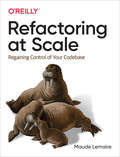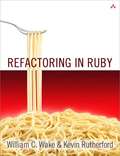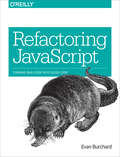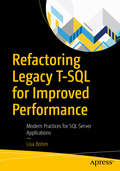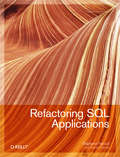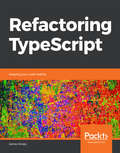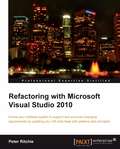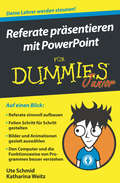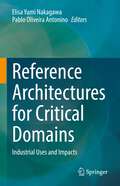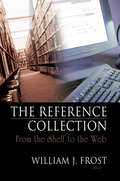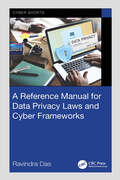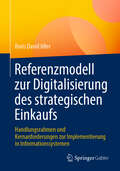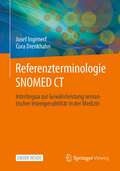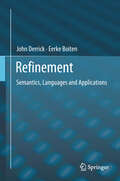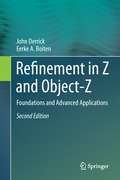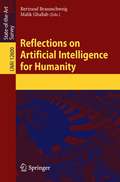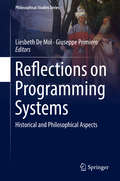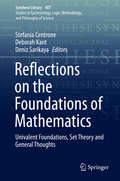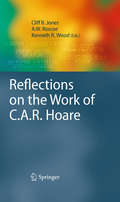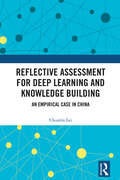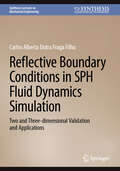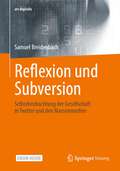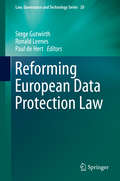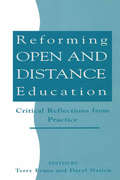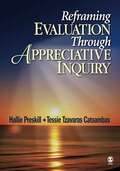- Table View
- List View
Refactoring at Scale: Regaining Control Of Your Codebase
by Maude LemaireMaking significant changes to large, complex codebases is a daunting task--one that's nearly impossible to do successfully unless you have the right team, tools, and mindset. If your application is in need of a substantial overhaul and you're unsure how to go about implementing those changes in a sustainable way, then this book is for you.Software engineer Maude Lemaire walks you through the entire refactoring process from start to finish. You'll learn from her experience driving performance and refactoring efforts at Slack during a period of critical growth, including two case studies illustrating the impact these techniques can have in the real world. This book will help you achieve a newfound ability to productively introduce important changes in your codebase.Understand how code degrades and why some degradation is inevitableQuantify and qualify the state of your codebase before refactoringDraft a well-scoped execution plan with strategic milestonesWin support from engineering leadershipBuild and coordinate a team best suited for the projectCommunicate effectively inside and outside your teamAdopt best practices for successfully executing the refactor
Refactoring in Ruby
by William C. Wake Kevin RutherfordRefactoring in Ruby gives you all the realistic, hands-on practice you need to refactor Ruby code quickly and effectively and shows when and how to refactor with both legacy code and during new test-driven development.
Refactoring JavaScript: Turning Bad Code Into Good Code
by Evan BurchardHow often do you hear people say things like this? "Our JavaScript is a mess, but we’re thinking about using [framework of the month]."Like it or not, JavaScript is not going away. No matter what framework or ”compiles-to-js” language or library you use, bugs and performance concerns will always be an issue if the underlying quality of your JavaScript is poor. Rewrites, including porting to the framework of the month, are terribly expensive and unpredictable. The bugs won’t magically go away, and can happily reproduce themselves in a new context. To complicate things further, features will get dropped, at least temporarily.The other popular method of fixing your JS is playing “JavaScript Jenga,” where each developer slowly and carefully takes their best guess at how the out-of-control system can be altered to allow for new features, hoping that this doesn’t bring the whole stack of blocks down. This book provides clear guidance on how best to avoid these pathological approaches to writing JavaScript:Recognize you have a problem with your JavaScript quality.Forgive the code you have now, and the developers who made it.Learn repeatable, memorable, and time-saving refactoring techniques.Apply these techniques as you work, fixing things along the way.Internalize these techniques, and avoid writing as much problematic code to begin with.Bad code doesn’t have to stay that way. And making it better doesn’t have to be intimidating or unreasonably expensive.
Refactoring Legacy T-SQL for Improved Performance: Modern Practices for SQL Server Applications
by Lisa BohmBreathe new life into older applications by refactoring T-SQL queries and code using modern techniques. This book shows you how to significantly improve the performance of older applications by finding common anti-patterns in T-SQL code, then rewriting those anti-patterns using new functionality that is supported in current versions of SQL Server, including SQL Server 2019. The focus moves through the different types of database objects and the code used to create them, discussing the limitations and anti-patterns commonly found for each object type in your database.Legacy code isn’t just found in queries and external applications. It’s also found in the definitions of underlying database objects such as views and tables. This book helps you quickly find problematic code throughout the database and points out where and how modern solutions can replace older code, thereby making your legacy applications run faster and extending their lifetimes. Author Lisa Bohm explains the logic behind each anti-pattern, helping you understand why each pattern is a problem and showing how it can be avoided. Good coding habits are discussed, including guidance on topics such as readability and maintainability. What You Will LearnFind specific areas in code to target for performance gainsIdentify pain points quickly and understand why they are problematicRewrite legacy T-SQL to reduce or eliminate hidden performance issuesWrite modern code with an awareness of readability and maintainabilityRecognize and correlate T-SQL anti-patterns with techniques for better solutionsMake a positive impact on application user experience in your organizationWho This Book Is ForDatabase administrators or developers who maintain older code, those frustrated with complaints about slow code when there is so much of it to fix, and those who want a head start in making a positive impact on application user experience in their organization
Refactoring SQL Applications
by Stephane Faroult Pascal L'HermiteWhat can you do when database performance doesn't meet expectations? Before you turn to expensive hardware upgrades to solve the problem, reach for this book. Refactoring SQL Applications provides a set of tested options for making code modifications to dramatically improve the way your database applications function. Backed by real-world examples, you'll find quick fixes for simple problems, in-depth answers for more complex situations, and complete solutions for applications with extensive problems. Learn to:Determine if and where you can expect performance gainsApply quick fixes, such as limiting calls to the database in stored functions and proceduresRefactor tasks, such as replacing application code by a stored procedure, or replacing iterative, procedural statements with sweeping SQL statementsRefactor flow by increasing parallelism and switching business-inducted processing from synchronous to asynchronousRefactor design using schema extensions, regular views, materialized views, partitioning, and moreCompare before and after versions of a program to ensure you get the same results once you make modificationsRefactoring SQL Applications teaches you to recognize and assess code that needs refactoring, and to understand the crucial link between refactoring and performance. If and when your application bogs down, this book will help you get it back up to speed.
Refactoring TypeScript: Keeping your code healthy
by James HickeyDiscover various techniques to develop maintainable code and keep it in shape. Key Features Learn all about refactoring - why it is important and how to do it Discover easy ways to refactor code with examples Explore techniques that can be applied to most other programming languages Book Description Refactoring improves your code without changing its behavior. With refactoring, the best approach is to apply small targeted changes to a codebase. Instead of doing a huge sweeping change to your code, refactoring is better as a long-term and continuous enterprise. Refactoring TypeScript explains how to spot bugs and remove them from your code. You'll start by seeing how wordy conditionals, methods, and null checks make code unhealthy and unstable. Whether it is identifying messy nested conditionals or removing unnecessary methods, this book will show various techniques to avoid these pitfalls and write code that is easier to understand, maintain, and test. By the end of the book, you'll have learned some of the main causes of unhealthy code, tips to identify them and techniques to address them. What you will learn Spot and fix common code smells to create code that is easier to read and understand Discover ways to identify long methods and refactor them Create objects that keep your code flexible, maintainable, and testable Apply the Single Responsibility Principle to develop less-coupled code Discover how to combine different refactoring techniques Learn ways to solve the issues caused by overusing primitives Who this book is for This book is designed for programmers who are looking to explore various refactoring techniques to develop healthy and maintainable code. Some experience in JavaScript and TypeScript can help you easily grasp the concepts explained in this book.
Refactoring with Microsoft Visual Studio 2010
by Peter RitchieThis book focuses on real-world, easy-to-understand examples of code in a one-on-one style. Refactoring examples are performed and reasons why this refactoring should be applied are detailed. The book is structured from less advanced topics to more advanced topics; but is designed so that reading from beginning to end is not necessary. This book is primarily for developers who want to refactor their code in Visual Studio. However, the book can be used by anyone using Visual Studio. Developers, designers, and architects who are eager to improve the performance of their craft will find this book useful because it details refactoring existing code to use recognized and established patterns and principles to improve code structure and architectural behavior. The book assumes that the reader knows both Visual Studio and C#, but no previous knowledge of refactoring is required.
Referate präsentieren mit PowerPoint für Dummies Junior (Für Dummies)
by Ute Schmid Katharina WeitzDu sollst ein Referat in der Schule halten und willst es richtig gut machen? Du hast schon mal in PowerPoint hineingeschaut, weißt aber nicht so genau, was man dort alles so machen kann? Du möchtest gern verstehen, wie der Computer arbeitet? Dann ist dieses Buch genau richtig für dich. Gestalte übersichtliche Folien, sodass dein Publikum schnell versteht, worum es geht. Wähle ein Design, erstelle Notizen, füge Bilder, Tabellen und Animationen ein. Finde heraus, wie Anwendersoftware aufgebaut ist und was du davon erwarten kannst. Bestens geeignet für Kinder und Jugendliche ab 10 Jahre. Du wirst von diesen Tipps und Techniken begeistert sein.
Reference Architectures for Critical Domains: Industrial Uses and Impacts
by Elisa Yumi Nakagawa Pablo Oliveira AntoninoThis book presents reference architecture as a key blueprint to develop and evolve critical software-intensive systems, emphasizing both the state of the art in research and successful industrial cases. After outlining the theoretical foundations of reference architecture and presenting an overview of a number of reference architectures proposed over the recent years, this book dives into a set of critical application domains, including defense, health, automotive, avionics, and Industry 4.0, highlighting the respective most relevant reference architectures that have impacted these domains, the experience and lessons learned, insights gained, benefits and drawbacks, and factors that make these architectures sustainable. The book finishes with the most relevant directions for future advances in reference architectures.The content of this book is useful for researchers and advanced professionals in industry in the areas of computing and engineering, as well as in critical application domains that increasingly require interconnected, large, and complex software-intensive systems.
The Reference Collection: From the Shelf to the Web
by Linda S KatzStay up-to-date with the growing amount of reference resources available onlineHow important is the World Wide Web to information retrieval and communication? Important enough that information professionals have seen students exit from their libraries en masse when Internet service was lost. Internet providers dominate the indexing and abstracting of periodical articles as major publishers now offer nearly all of their reference titles in digital form. Libraries spend increasing amounts of funding on electronic reference materials, and librarians devote an increasing amount of time to assisting in their use. The Reference Collection: From the Shelf to the Web is an essential guide to collection development for electronic materials in academic and public libraries. The Reference Collection: From the Shelf to the Web tracks the continuing evolution of electronic reference resources-and how they&’re accessed-in a variety of settings. Librarians representing university, elementary school, and public libraries in the United States and Australia examine how reference collections have evolved over time (and may soon be a thing of the past); how public and school libraries have dealt with the changes; why library research assignments have become more difficult for teachers to make and for students to complete; how to organize online reference sources; and why the nature of plagiarism has changed in the electronic era. The book also examines the use of electronic references from a publisher&’s perspective and looks at the most important Web-accessible reference tools-both free and subscription-in the areas of humanities, medicine, the social sciences, business, and education. The Reference Collection: From the Shelf to the Web also examines: issues of authority, accessibility, cost, comfort, and user education in evaluating electronic resources the formation of purchasing consortia to facilitate the transfer of reference materials from print to online formats current literature and research findings on the state of digital versus print reference collections what electronic publishing means to smaller reference books (dictionaries, almanacs, etc.) the need for increased information literacy among students the nature, extent, and causes of cyber plagiarism the use of federated search tools and includes a selected list of the top 100 free Internet reference sitesThe Reference Collection: From the Shelf to the Web is an essential resource for all reference and collection development librarians, and an invaluable aid for publishing professionals.
A Reference Manual for Data Privacy Laws and Cyber Frameworks (Cyber Shorts)
by Ravindra DasAs the world is becoming more digital and entwined together, the cybersecurity threat landscape has no doubt become a daunting one. For example, typical threat variants of the past, especially those of phishing, have now become much more sophisticated and covert in nature. A lot of this has been brought on by the proliferation of ransomware, which exploded during the COVID-19 pandemic. Now, there is another concern that is looming on the horizon: data privacy. Now, more than ever, consumers on a global basis want to know exactly what is happening to their personal identifiable information (PII) datasets. Examples of what they want to know about include the following: What kinds and types of information and data are being collected about them How those PII datasets are being stored, processed, and transacted with How their PII datasets are being used by third-party suppliers In response to these concerns and fears, as well as the cyber risks posed by these datasets, many nations around the world have set up rather extensive and very detailed data privacy laws. In their respective tenets and provisions, these pieces of legislation not only specify why and how businesses need to comply with them, but also outline the rights that are afforded to each and every consumer. In this book, we detail the tenets and provisions of three key data privacy laws: The GDPR The CCPA The CMMC We also provide a general framework at the end on how a business can comply with these various data privacy laws.The book begins with an in-depth overview of the importance of data and datasets, and how they are so relevant to the data privacy laws just mentioned.
Referenzmodell zur Digitalisierung des strategischen Einkaufs: Handlungsrahmen und Kernanforderungen zur Implementierung in Informationssystemen
by Boris David IdlerDieses Buch beschreibt einen anforderungsorientierten Handlungsrahmen zur Gestaltung digitaler Einkaufsprozesse. Das dafür entworfene Referenzmodell dient dabei als Ausgangspunkt mehrerer Ableitungen und ermöglicht ein grundlegendes Verständnis über die prozessualen Aufgaben im strategischen Einkauf, um die Ziele der Einkaufsorganisation zu unterstützen. Neben Lieferantenqualifikation oder Kostenmanagement werden auch Prozesse beschrieben, die erst durch eine Digitalisierung möglich sind. Damit kann die Überführung der Prozesse in Anforderungen an IT-Systeme vollzogen und auch der Frage nachgegangen werden, inwiefern die einzelnen Kernprozesse zu integrierten Prozessnetzwerken verbunden werden sollten.
Referenzterminologie SNOMED CT: Interlingua zur Gewährleistung semantischer Interoperabilität in der Medizin
by Josef Ingenerf Cora DrenkhahnSNOMED CT wird zunehmend auch in Deutschland als wesentlicher Baustein innovativer digitaler Gesundheitsanwendungen verwendet. Sie gilt mit über 350.000 formal definierten Konzepten sowie mehrsprachigen Bezeichnungen als ausdrucksmächtigste internationale Referenzterminologie. Gleichwohl stellt die Einführung von SNOMED CT mit dem Potenzial zur Postkoordination „neuer Konzepte“ einen Paradigmenwechsel dar. Dieser geht einher mit vielfältigsten methodischen Grundlagen, die interessierten Anwendern und Software-Entwicklern vermittelt werden müssen, um den erwarteten Nutzen realisieren zu können. Dieses Buch soll hierzu einen Beitrag leisten.
Refinement: Foundations And Advanced Applications (Formal Approaches To Computing And Information Technology (facit) Ser.)
by Eerke Boiten John DerrickRefinement is one of the cornerstones of a formal approach to software engineering. Refinement is all about turning an abstract description (of a soft or hardware system) into something closer to implementation. It provides that essential bridge between higher level requirements and an implementation of those requirements. This book provides a comprehensive introduction to refinement for the researcher or graduate student. It introduces refinement in different semantic models, and shows how refinement is defined and used within some of the major formal methods and languages in use today. It (1) introduces the reader to different ways of looking at refinement, relating refinement to observations(2) shows how these are realised in different semantic models (3) shows how different formal methods use different models of refinement, and (4) how these models of refinement are related.
Refinement in Z and Object-Z: Foundations and Advanced Applications
by Eerke A. Boiten John DerrickRefinement is one of the cornerstones of the formal approach to software engineering, and its use in various domains has led to research on new applications and generalisation. This book brings together this important research in one volume, with the addition of examples drawn from different application areas. It covers four main themes: Data refinement and its application to ZGeneralisations of refinement that change the interface and atomicity of operationsRefinement in Object-ZModelling state and behaviour by combining Object-Z with CSPRefinement in Z and Object-Z: Foundations and Advanced Applications provides an invaluable overview of recent research for academic and industrial researchers, lecturers teaching formal specification and development, industrial practitioners using formal methods in their work, and postgraduate and advanced undergraduate students. This second edition is a comprehensive update to the first and includes the following new material: Early chapters have been extended to also include trace refinement, based directly on partial relations rather than through totalisationProvides an updated discussion on divergence, non-atomic refinements and approximate refinementIncludes a discussion of the differing semantics of operations and outputs and how they affect the abstraction of models written using Object-Z and CSPPresents a fuller account of the relationship between relational refinement and various models of refinement in CSPBibliographic notes at the end of each chapter have been extended with the most up to date citations and research
Reflections on Artificial Intelligence for Humanity (Lecture Notes in Computer Science #12600)
by Bertrand Braunschweig Malik GhallabWe already observe the positive effects of AI in almost every field, and foresee its potential to help address our sustainable development goals and the urgent challenges for the preservation of the environment. We also perceive that the risks related to the safety, security, confidentiality, and fairness of AI systems, the threats to free will of possibly manipulative systems, as well as the impact of AI on the economy, employment, human rights, equality, diversity, inclusion, and social cohesion need to be better assessed. The development and use of AI must be guided by principles of social cohesion, environmental sustainability, resource sharing, and inclusion. It has to integrate human rights, and social, cultural, and ethical values of democracy. It requires continued education and training as well as continual assessment of its effects through social deliberation. The “Reflections on AI for Humanity” proposed in this book develop the following issues and sketch approaches for addressing them:How can we ensure the security requirements of critical applications and the safety and confidentiality of data communication and processing? What techniques and regulations for the validation, certification, and audit of AI tools are needed to develop confidence in AI? How can we identify and overcome biases in algorithms? How do we design systems that respect essential human values, ensuring moral equality and inclusion?What kinds of governance mechanisms are needed for personal data, metadata, and aggregated data at various levels? What are the effects of AI and automation on the transformation and social division of labor? What are the impacts on economic structures? What proactive and accommodation measures will be required?How will people benefit from decision support systems and personal digital assistants without the risk of manipulation? How do we design transparent and intelligible procedures and ensure that their functions reflect our values and criteria? How can we anticipate failure and restore human control over an AI system when it operates outside its intended scope?How can we devote a substantial part of our research and development resources to the major challenges of our time such as climate, environment, health, and education?
Reflections on Programming Systems: Historical And Philosophical Aspects (Philosophical Studies Series #133)
by Liesbeth De Mol Giuseppe PrimieroThis book presents a historical and philosophical analysis of programming systems, intended as large computational systems like, for instance, operating systems, programmed to control processes. The introduction to the volume emphasizes the contemporary need of providing a foundational analysis of such systems, rooted in a broader historical and philosophical discussion. <P><P> The different chapters are grouped around three major themes. The first concerns the early history of large systems developed against the background of issues related to the growing semantic gap between hardware and code. The second revisits the fundamental issue of complexity of large systems, dealt with by the use of formal methods and the development of `grand designs’ like Unix. Finally, a third part considers several issues related to programming systems in the real world, including chapters on aesthetical, ethical and political issues. <P><P> This book will interest researchers from a diversity of backgrounds. It will appeal to historians, philosophers, as well as logicians and computer scientists who want to engage with topics relevant to the history and philosophy of programming and more specifically the role of programming systems in the foundations of computing.
Reflections on the Foundations of Mathematics: Univalent Foundations, Set Theory and General Thoughts (Synthese Library #407)
by Stefania Centrone Deborah Kant Deniz SarikayaThis edited work presents contemporary mathematical practice in the foundational mathematical theories, in particular set theory and the univalent foundations. It shares the work of significant scholars across the disciplines of mathematics, philosophy and computer science. Readers will discover systematic thought on criteria for a suitable foundation in mathematics and philosophical reflections around the mathematical perspectives.The volume is divided into three sections, the first two of which focus on the two most prominent candidate theories for a foundation of mathematics. Readers may trace current research in set theory, which has widely been assumed to serve as a framework for foundational issues, as well as new material elaborating on the univalent foundations, considering an approach based on homotopy type theory (HoTT). The third section then builds on this and is centred on philosophical questions connected to the foundations of mathematics. Here, the authors contribute to discussions on foundational criteria with more general thoughts on the foundations of mathematics which are not connected to particular theories.This book shares the work of some of the most important scholars in the fields of set theory (S. Friedman), non-classical logic (G. Priest) and the philosophy of mathematics (P. Maddy). The reader will become aware of the advantages of each theory and objections to it as a foundation, following the latest and best work across the disciplines and it is therefore a valuable read for anyone working on the foundations of mathematics or in the philosophy of mathematics.
Reflections on the Work of C.A.R. Hoare
by A. W. Roscoe Kenneth R. Wood Cliff B. JonesThousands of different programming languages exist, and many more are being created each year, yet all those involved in such work must acknowledge that it is "the highest goal of programming language design to enable good ideas to be elegantly expressed". These are the words of Sir Charles Antony Richard Hoare, or Tony Hoare to his colleagues and friends, a man who has inspired generations of researchers in computer science. His work, grounded in practical programming, has had a profound impact on the evolution of the field. This includes the development of Hoare logic and Communicating Sequential Processes (CSP). Reflections on the Work of C.A.R. Hoare presents a comprehensive edited survey of all aspects of these subjects, with original contributions by more than 30 international leaders in the field. The book, while honoring Hoare's important contributions, assembles a collection of chapters showing the state of the art in programming languages, sequential programs, concurrency, and unified theories of programming. Topics and features: demonstrates a principled combination of CSP and functional programming, and the expression of CSP semantics to π-calculus; reviews methods for proving Hoare formulae based on the computation of postconditions and preconditions; investigates developments in game semantics and semantics based on the state monad; examines the satisfiability problem, void safety, and issues of auxiliary variables; introduces type families in Haskell and a description of Quicksort in Orc; describes an experiment using the Tokeneer archive, and a correctness proof of cryptographic protocols based on the Shadow Security model; presents a representation of CSP as a bigraphical reactive system, and shows how simple entities can be related to CSP processes; discusses the problem frames approach, and explores algebraic properties of the new programming combinators. This accessible monograph is an ideal overview of theoretical and empirical evolution in programming logic and semantics of programming languages. It will serve as an invaluable resource for professionals, researchers, libraries, and students who are interested in broadening their knowledge in all of the areas covered.
Reflective Assessment for Deep Learning and Knowledge Building: An Empirical Case in China
by Chunlin LeiKnowledge building aims to transform schools into learning communities and bring knowledge creation into schools. The book therefore elaborates on how learning, technology, and assessment can be aligned both online and offline to facilitate such a process.Adopting a quasi-experimental design and drawing on rich data from forum discussions, questionnaires, interviews, learning outcomes, and classroom presentations, this book shows that the knowledge building environment, augmented by reflective assessment and principles, helped Chinese students to develop a deeper approach to learning, improved academic performance, and promoted collective knowledge advances. The book also discusses the potentials and challenges of designing technology-supported, assessment- and principle-based learning environments in tertiary contexts, especially when deep learning and knowledge building capacity are greatly emphasised in the knowledge era.The book will be of interest to scholars and educators working in learning sciences and computer-supported collaborative learning.
Reflective Boundary Conditions in SPH Fluid Dynamics Simulation: Two and Three-dimensional Validation and Applications (Synthesis Lectures on Mechanical Engineering)
by Carlos Alberto Fraga FilhoThis book presents results from applying Reflective Boundary Conditions (RBC) in particle simulations coupled with the Smoothed Particle Hydrodynamics (SPH) Method in two- and three-dimensional domains. The contribution of this work lies in the presentation of the state of the art regarding the application of physical and realistic boundary conditions in the continuum domain, which is an advance in the artificial computational boundary treatment carried out in most SPH simulations. By reading this work, researchers from different fields dealing with Computational Fluid Dynamics (CFD) will be aware of the most recent results of applying the SPH method coupled with RBC, confirming its scientific validity and encouraging its implementation in other problems. This multidisciplinary work is aimed at undergraduate and postgraduate students, researchers, software developers, and other engineering, physics, chemistry, mathematics, and related sciences professionals.
Reflexion und Subversion: Selbstbeobachtung der Gesellschaft in Twitter und den Massenmedien (ars digitalis)
by Samuel BreidenbachDie ehemals den Massenmedien vorbehaltene Funktion, die Gesellschaft zu reflektieren und diese gesellschaftlichen Selbstbeschreibungen auch gesellschaftsweit bekannt zu machen, kann heute auch von Social-Media-Plattformen erfüllt werden, wenn die Nutzer*innen dort die Gesellschaft beschreiben und diese Beiträge massenhaft verbreitet werden. Gleichzeitig unterscheiden sich die in den Social Media verbreiteten Gesellschaftsbeschreibungen enorm von jenen herkömmlicher Massenmedien – nicht zuletzt aufgrund der technischen Infrastrukturen der Plattformen. Aus Perspektive der sozialen Systemtheorie werden am Beispiel von Twitter Gemeinsamkeiten und Differenzen zwischen diesen beiden Formen gesellschaftlicher Selbstreflexion herausgearbeitet. Vor allem aber soll die Analyse die grundsätzlich divergenten Wirkungen aufzeigen, welche die (Selbst-)Reflexion der Gesellschaft nach sich ziehen kann, wenn diese einerseits gesellschaftliche Komplexität als einheitliche Realität greifbar macht und damit der Selbstvergewisserung dient, andererseits genauso die Kritik und das Hinterfragen des Bestehenden erlaubt.
Reforming European Data Protection Law
by Serge Gutwirth Ronald Leenes Paul De HertThis book on privacy and data protection offers readers conceptual analysis as well as thoughtful discussion of issues, practices, and solutions. It features results of the seventh annual International Conference on Computers, Privacy, and Data Protection, CPDP 2014, held in Brussels January 2014. The book first examines profiling, a persistent core issue of data protection and privacy. It covers the emergence of profiling technologies, on-line behavioral tracking, and the impact of profiling on fundamental rights and values. Next, the book looks at preventing privacy risks and harms through impact assessments. It contains discussions on the tools and methodologies for impact assessments as well as case studies. The book then goes on to cover the purported trade-off between privacy and security, ways to support privacy and data protection, and the controversial right to be forgotten, which offers individuals a means to oppose the often persistent digital memory of the web. Written during the process of the fundamental revision of the current EU data protection law by the Data Protection Package proposed by the European Commission, this interdisciplinary book presents both daring and prospective approaches. It will serve as an insightful resource for readers with an interest in privacy and data protection.
Reforming Open and Distance Education: Critical Reflections from Practice (Open and Flexible Learning Series)
by Terry Evans Daryl NationThis volume contains a collection of critical reflections by teachers and administrators in open and distance education. They highlight educational problems and issues of a more general nature caused by the increased use of distance education within conventional higher education institutions.
Reframing Evaluation Through Appreciative Inquiry
by Hallie Preskill Anastasia Tessie Tzavaras CatsambasReframing Evaluation Through Appreciative Inquiry is the first book to introduce the application of Appreciative Inquiry (AI), an approach for organizational development and change, to the practice of evaluation. Authors Hallie Preskill and Tessie Tzavaras Catsambas lay out the theoretical foundation of AI and build a bridge between the theory and practice of applying AI to evaluation.
